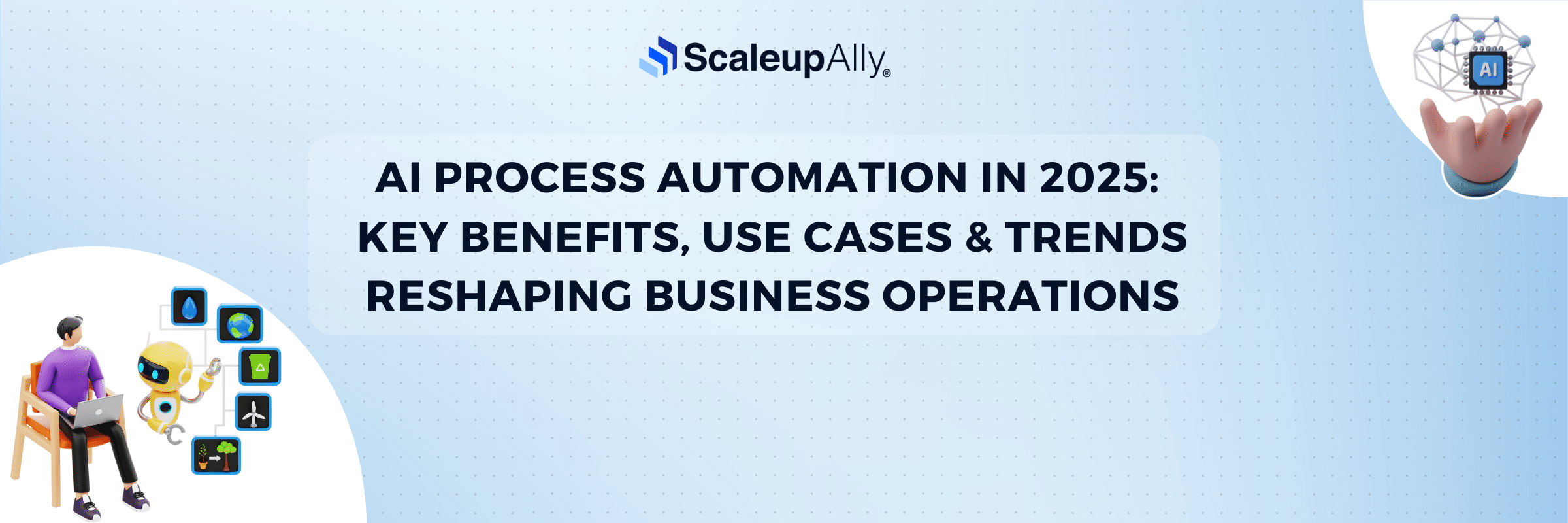
AI Process Automation in 2025: Key Benefits, Use Cases & Trends Reshaping Business Operations
Manu Jain | June 28, 2025 , 16 min read
Table Of Content
Business leaders are discovering that the manual processes they’ve relied on for decades are no longer just inefficient; they’re becoming impossible to sustain.
As companies race to meet accelerating market demands, the very nature of work is being reshaped. We are talking about artificial intelligence automation. AI process automation has moved from the experimental phase into something consequential.
McKinsey research explains it better. It suggests that up to 375 million workers globally may need to switch occupational categories by 2030 due to automation. This is not necessarily about job displacement, but the emergence of hybrid workflows where artificial intelligence handles the predictable while humans focus on the exceptional.
This shift is happening faster than most organizations anticipated. In this blog, we explore what AI process automation is, its key benefits, real-world use cases, latest trends, top tools, and how to implement it in your business.
Key Takeaways
- AI process automation learns, adapts, and handles complex decisions that traditional automation can’t manage
- Start small with high-volume, low-risk processes like invoice processing or data entry to prove ROI before expanding to more complex workflows
- Clean, standardized data determines whether your AI automation succeeds or fails spectacularly
- JP Morgan saves 360,000 hours annually, while others report 25-40% cost reductions in the first year
- 2025 trends favor autonomous AI agents that work independently, plus democratized tools that let non-technical employees build their own automation solutions
What is AI Process Automation?
- What is AI Process Automation?
- Benefits of AI Process Automation for Businesses
- How Can Businesses Implement AI to Automate their Processes?
- Real World Use Cases of AI Process Automation
- Challenges of AI Process Automation
- Difference Between Intelligent Automation and AI Process Automation
- Latest Trends in AI Process Automation To Follow in 2025
- Top AI Process Automation Tools for Businesses
- How Can ScaleupAlly Help?
- Conclusion
- Frequently Asked Questions
Most people think automation means robots on assembly lines. AI process automation represents something more sophisticated in the sense that, instead of following rigid, pre-programmed rules, AI-driven automation learns patterns, makes decisions, and adapts to new situations without constant human intervention.
For example, traditional automation could handle structured tasks like data entry or invoice processing. But business process automation with AI tackles the messy, nuanced work that requires judgment calls. It reads unstructured documents, interprets customer emotions in support tickets, and even predicts when equipment might fail based on subtle performance patterns.
Benefits of AI Process Automation for Businesses
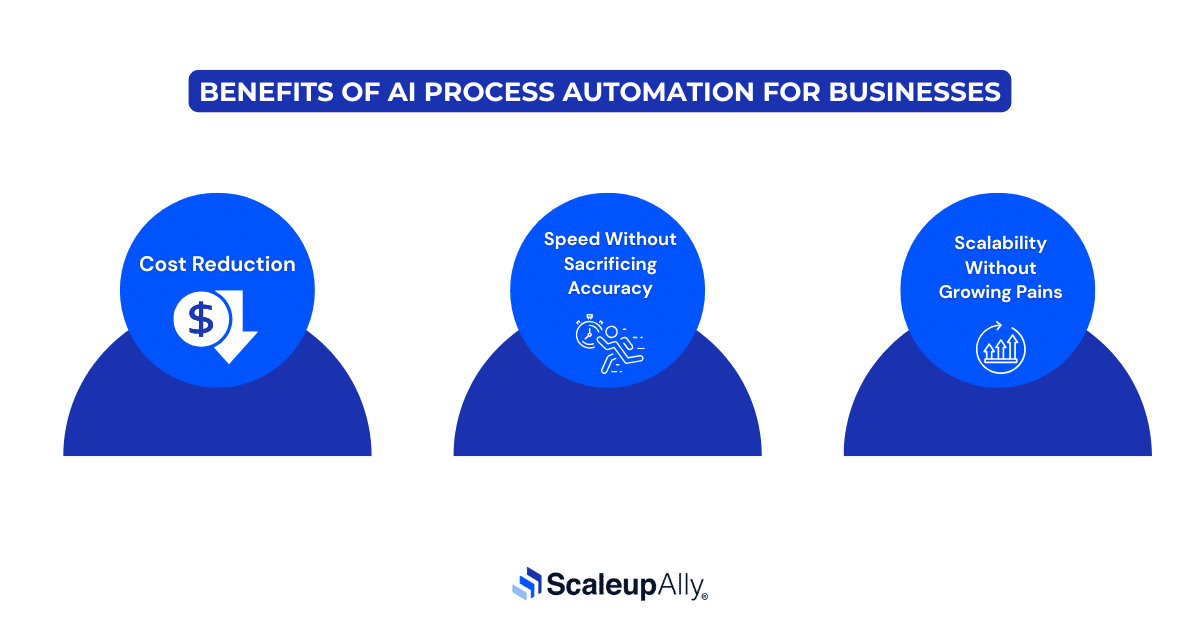
AI process automation is changing how businesses operate by making tasks faster and smarter. Here are its key advantages:
1. Cost Reduction
Most cost-cutting initiatives fail because they’re surface-level fixes. AI process automation eliminates entire categories of operational waste. Companies can see 25-40% reductions in processing costs within the first year. But these aren’t one-time savings. The AI continuously optimizes processes and finds inefficiencies that humans miss. The automation works faster and smarter to catch errors that compound into significant losses over time.
2. Speed Without Sacrificing Accuracy
Human workers face an impossible trade-off: work fast and make mistakes, or work carefully and fall behind. AI process automation breaks this constraint entirely. Document processing that usually takes days can now happen in minutes, with accuracy rates exceeding 99%. Insurance claims processing offers a perfect example. AI systems review medical records, cross-reference policy details, and flag potential fraud simultaneously. What’s remarkable is the speed increase and how accuracy improves alongside it. The AI doesn’t get tired at 4 PM or distracted by urgent emails. It maintains peak performance consistently and delivers results that are both faster and more reliable than manual processes.
3. Scalability Without Growing Pains
Traditional scaling means hiring more people, training them, managing increased complexity, and hoping quality doesn’t suffer. AI process automation scales differently. Do you need to process 10x more customer inquiries? The system handles it without breaking stride. The beauty is in predictable scaling costs. Instead of linear increases in headcount and overhead, businesses invest once in robust AI systems that grow with demand. This transforms scaling into a competitive advantage.
How Can Businesses Implement AI to Automate their Processes?
Implementation here doesn’t mean ripping out existing systems and starting fresh, but identifying specific pain points where AI can deliver immediate impact while building toward broader transformation. Start small, prove value, then expand systematically. Here are some points to guide you:
1. Start with High-Volume, Low-Risk Processes
Pick your battles carefully. Begin with processes that are repetitive, well-documented, and won’t bring operations to a halt if something goes wrong. Invoice processing, data entry, and basic customer inquiries make excellent starting points. These areas typically have clear inputs, predictable outputs, and existing quality metrics to measure improvement against. A manufacturing company might automate purchase order approvals first because of high frequency, standardized format, and minimal risk if delayed. Success here builds internal confidence and provides concrete ROI data to justify expanding into more complex processes. The goal is to demonstrate progress that creates momentum for larger initiatives.
2. Invest in Data Quality Before Technology
Garbage in, garbage out applies ruthlessly to AI systems. Many implementations fail because the underlying data is messy, incomplete, or inconsistent. Spend time cleaning historical records, standardizing formats, and establishing data governance protocols before deploying AI solutions. This preparation phase feels tedious, but it determines everything that follows. Consider a healthcare provider trying to automate patient scheduling. Success depends entirely on accurate patient records, consistent appointment coding, and reliable provider availability data. Companies that rush past this foundation end up with AI systems that make confidently wrong decisions. The unglamorous work of data preparation pays dividends throughout the automation lifecycle.
3. Build Internal AI Literacy First
Technology adoption fails when people don’t understand what they’re working with. Before implementing AI process automation, invest in educating your team about capabilities, limitations, and realistic expectations. We are not suggesting that you turn everyone into data scientists. The point we are making is that build comfort with AI-augmented workflows. Employees who understand how AI makes decisions are more likely to trust and effectively collaborate with automated systems. They’ll also spot potential issues early and suggest improvements based on their process expertise. Training should focus on practical collaboration. For example, when to override AI decisions, how to provide feedback that improves system performance, and recognizing signs that automated processes need human intervention.
Real World Use Cases of AI Process Automation
Companies across industries are moving beyond pilot programs into full-scale implementations that deliver measurable outcomes. Below are key use cases showcasing how AI optimizes important business functions across various domains:
1. JP Morgan Chase
JP Morgan’s COIN (Contract Intelligence) platform processes approximately 12,000 commercial credit agreements annually, saving upwards of 360,000 hours of human work. This AI business process automation system analyzes complex legal documents in seconds rather than the hours or days required by human lawyers. The bank’s CTO noted, “We’re starting to see the real fruits of our labor. This is not pie-in-the-sky stuff.” COIN doesn’t just read contracts, it extracts critical data points, identifies potential risks, and flags inconsistencies that human reviewers often miss. The system has transformed how JP Morgan handles loan agreements, reducing processing time from weeks to minutes while improving accuracy rates.
2. Siemens Mobility
Siemens Mobility has automated more than 700 processes since 2017. This has demonstrated how automation and AI can scale across complex industrial operations. The company implemented AI process automation across its global workforce of 38,000 employees by focusing on repetitive tasks in manufacturing, logistics, and customer service. Their approach involves over 300 locally and virtually ai processes that handle everything from inventory management to customer inquiry processing. The results include faster response times to customer requests, reduced manual errors in manufacturing processes, and significant cost savings in administrative tasks. This has become a model for other industrial companies seeking digital transformation.
3. Dentsu
Dentsu, a global digital marketing company, used AI for process automation to build 60 AI driven automations in 6 days, saving 125K hours in the process. They successfully extracted and migrated over 2.8 million records. This massive data migration project would have taken months with traditional methods, but AI-powered automation completed it within a week. The AI handled complex data extraction from multiple legacy systems, standardized formats across different databases, and ensured data integrity throughout the migration process. This case demonstrates how AI business process automation can handle time-sensitive, large-scale projects that would be impossible to complete manually within tight deadlines. The success enabled Dentsu to improve data analysis capabilities and maintain business continuity during system transitions.
4. EY
EY expanded from 5 to 500 AI process automations in 18 months, showcasing rapid scaling of automation across professional services. EY’s implementation focused on automating repetitive tasks in audit preparation, tax document processing, and client report generation. The firm used AI process automation to handle data collection from multiple client systems, perform preliminary analysis of financial records, and generate standardized reports. This allowed EY consultants to focus on higher-value strategic work while ensuring consistent quality across all client engagements. The 100x increase in automation deployment demonstrates how professional services firms can leverage AI to enhance service delivery without proportionally increasing headcount.
5. VITAL
VITAL serves 450% more agencies, while saving 15,000 work hours in payroll processing operations. VITAL’s automation handles complex payroll calculations, tax withholdings, and compliance reporting across multiple agencies with different requirements. The AI system processes employee timesheets, calculates overtime and benefits, generates pay statements, and ensures regulatory compliance automatically. This automation and AI solution eliminated manual data entry errors that previously caused payroll discrepancies and compliance issues. The 450% increase in processing capacity without proportional staff increases demonstrates the scalability potential of AI process automation in administrative functions.
6. Healthcare
AI process automation is revolutionizing healthcare administration through automated medical records processing, insurance claims verification, and patient scheduling systems. Hospitals deploy AI systems that extract patient information from various sources, verify insurance coverage, and process claims submissions automatically. These systems handle unstructured data from doctors’ notes, lab results, and imaging reports, and convert them into standardized formats for billing and treatment planning. The automation reduces processing time from days to hours while improving accuracy in medical coding and billing. Healthcare providers report significant reductions in administrative costs and faster patient onboarding to allow medical staff to focus on patient care rather than paperwork management.
Challenges of AI Process Automation
While the benefits of AI process automation are compelling, implementation comes with genuine obstacles that can derail projects if not addressed proactively. Here are some obstacles you may encounter and how you can find your way around them:
1. Integration Complexity with Legacy Systems
Most businesses aren’t starting with a blank slate. They’re wrestling with decades-old systems that weren’t designed to integrate with modern AI platforms. Legacy databases use outdated formats, proprietary protocols, and incompatible data structures that resist seamless integration. Different departments often guard their systems jealously, which creates political barriers alongside technical ones. Success requires dedicated integration specialists, substantial upfront investment, and patience as teams work through compatibility issues that reveal themselves only during testing phases.
2. Data Quality and Governance Issues
AI and process automation systems are only as reliable as the data feeding them. Poor data quality creates a cascade of problems: inaccurate outputs, failed processes, and eroded trust in automated systems. Many companies discover their data isn’t automation-ready only after implementation begins. Inconsistent naming conventions, duplicate records, missing fields, and outdated information plague most enterprise databases. Establishing data governance requires sustained effort (standardizing formats, cleaning historical records, and maintaining quality controls). This unglamorous work often gets deprioritized, but skipping it guarantees automation problems down the road.
3. Change Management and Employee Resistance
The human element often derails AI automation projects more than technical challenges do. Employees fear job displacement, resist new workflows, and sometimes actively sabotage systems they view as threats. Middle managers worry about losing relevance if their teams shrink. Seasoned workers resent having to learn new processes after decades of expertise. This resistance manifests in subtle ways: providing incomplete training data, failing to report system errors, or reverting to manual processes when AI systems encounter edge cases. Successfully applying AI in business requires extensive change management (transparent communication about job impacts, retraining programs, and demonstrating how AI augments rather than replaces human work). Companies that treat this as an afterthought often find their technically sound systems sitting unused.
Difference Between Intelligent Automation and AI Process Automation
Intelligent automation orchestrates multiple technologies to transform entire business workflows, whereas AI process automation focuses its artificial intelligence on perfecting individual processes.
Most companies start with AI process automation (it’s less risky, shows faster results, and builds internal confidence). Once they’ve proven success with targeted implementations, they expand toward intelligent automation for comprehensive transformation.
The choice depends on your organization’s current state, risk tolerance, and transformation timeline. Both deliver value, but they serve different strategic purposes in your automation journey.
Latest Trends in AI Process Automation To Follow in 2025
Companies that stay ahead of these trends will gain significant competitive advantages, while those that lag behind risk becoming obsolete in their markets.
1. Agentic AI
Agentic AI (AI that does tasks independently) is a sure bet for 2025’s “most trending AI trend.” These systems move beyond static responses to goal-seeking behaviors, autonomously managing complex workflows without human oversight.
2. Citizen Developers Building AI Automation
Forrester predicted that citizen developers will construct 30% of “GenAI-infused automation apps” this year. Non-technical employees are now creating sophisticated automation solutions using low-code platforms and AI assistants. This democratization accelerates deployment timelines and reduces IT bottlenecks, allowing departments to solve their own process challenges rapidly.
3. Multimodal AI Revolutionizing Complex Processes
Multimodal AI (capable of processing and generating diverse data types, from CAD files to simulations) is now revolutionizing product design and broader R&D processes. These systems simultaneously handle text, images, audio, and structured data, enabling automation of previously impossible tasks like visual quality control combined with documentation analysis.
Top AI Process Automation Tools for Businesses
Choosing the right AI automation platform can make or break your implementation success. These tools have proven themselves in enterprise environments, offering robust capabilities that scale from small departmental projects to organization-wide transformations. Each brings distinct strengths to different automation challenges.
1. UiPath
UiPath is commonly used to automate larger and more complex processes, making it ideal for enterprises requiring sophisticated automation workflows. The platform combines traditional RPA with advanced AI capabilities, handling everything from document processing to complex decision-making tasks across multiple systems and departments.
2. Microsoft Power Automate
Part of the Microsoft Power Platform, Power Automate makes it easy to create workflows across 350+ apps and services with its user-friendly interface. Perfect for organizations already invested in Microsoft’s ecosystem, it seamlessly integrates with Office 365, Teams, and Azure services while offering robust AI-powered automation capabilities.
3. Zapier
Startups and small businesses often lean toward the simplicity and ease of Zapier. This platform excels at connecting different web applications through simple trigger-action workflows. While less complex than enterprise solutions, its AI-enhanced features and extensive app library make automation accessible to non-technical users.
How Can ScaleupAlly Help?
Most businesses stumble at the implementation phase. They understand AI automation’s potential but lack the expertise to execute without costly mistakes. ScaleupAlly bridges this gap by combining strategic consulting with hands-on technical execution. We don’t just recommend tools; we build custom automation solutions for your workflows and constraints.
Our approach starts with process auditing to identify the highest-impact automation opportunities, followed by rapid prototyping that proves ROI before full deployment. We handle the messy integration work with legacy systems, establish data governance frameworks, and train your team to manage automated processes confidently. The result is faster time-to-value and sustainable automation that works in your environment.
Conclusion
AI process automation isn’t waiting for your industry to catch up. While you’re weighing options, competitors are already capturing market advantages through intelligent workflows that reduce costs, accelerate operations, and improve customer experiences. The window for early adoption benefits is closing fast.
Ready to turn AI automation from a competitive threat into a competitive advantage? Contact us today and discover how your processes can work smarter, not harder.
Frequently Asked Questions
Q: How is AI used in process automation?
AI transforms automation from rigid rule-following to intelligent decision-making. Instead of just executing predetermined steps, AI systems analyze patterns, understand context, and adapt to new situations. They read unstructured documents, interpret customer emotions, predict equipment failures, and handle exceptions without breaking down. Think of it as automation with judgment—capable of processing invoices with missing information, routing support tickets based on urgency, or flagging unusual transactions for review.
Q: What are some popular AI automation tools?
UiPath leads enterprise automation with sophisticated RPA and AI capabilities for complex workflows. Microsoft Power Automate excels in organizations using Microsoft ecosystems, connecting 350+ applications seamlessly. Zapier offers no-code simplicity perfect for small businesses connecting web apps. Other notable mentions include Automation Anywhere for enterprise-scale deployments and Blue Prism for heavily regulated industries requiring strict governance controls.
Q: What industries benefit most from AI automation?
Financial services see dramatic results in fraud detection, loan processing, and regulatory compliance. Healthcare automates patient records, insurance claims, and appointment scheduling. Manufacturing optimizes supply chains, quality control, and predictive maintenance. Retail transforms inventory management, customer service, and order processing. Professional services like accounting and legal firms automate document review, data entry, and client reporting. Any industry with repetitive processes and large data volumes benefits significantly.
Q: Is AI process automation expensive to implement?
Costs vary based on scope and complexity. Small-scale implementations using tools like Zapier can start under $100 monthly. Mid-market solutions like Power Automate range from $15-40 per user monthly. Enterprise platforms like UiPath require significant upfront investment, often $50,000-$500,000 for comprehensive deployments. However, ROI typically appears within 6-18 months. Most companies report 25-40% cost reductions in automated processes, with some saving millions annually in operational expenses.
Related Blogs
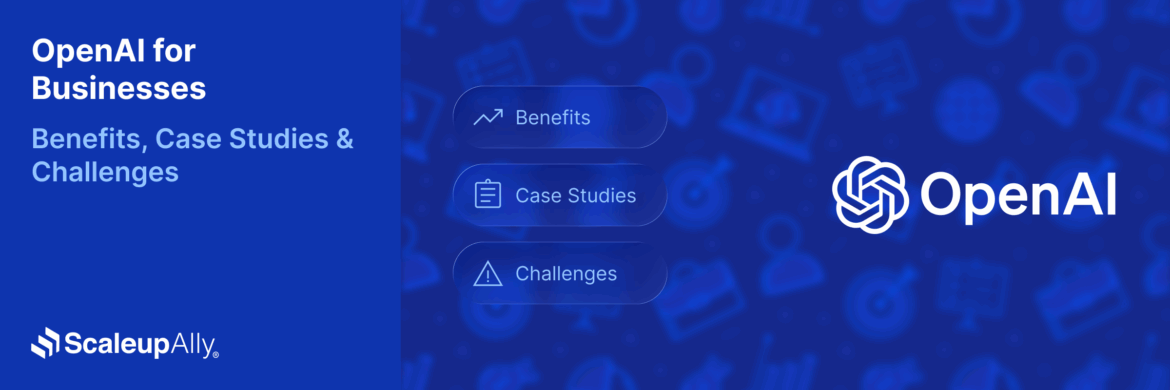
OpenAI for Businesses [Benefits, Use Cases & Challenges]
Discover the benefits of OpenAI for businesses. From reducing costs to scaling operations and enriching customer experiences. Real-world use cases included.
ScaleupAlly Team
Dec 16 ,
11 min read
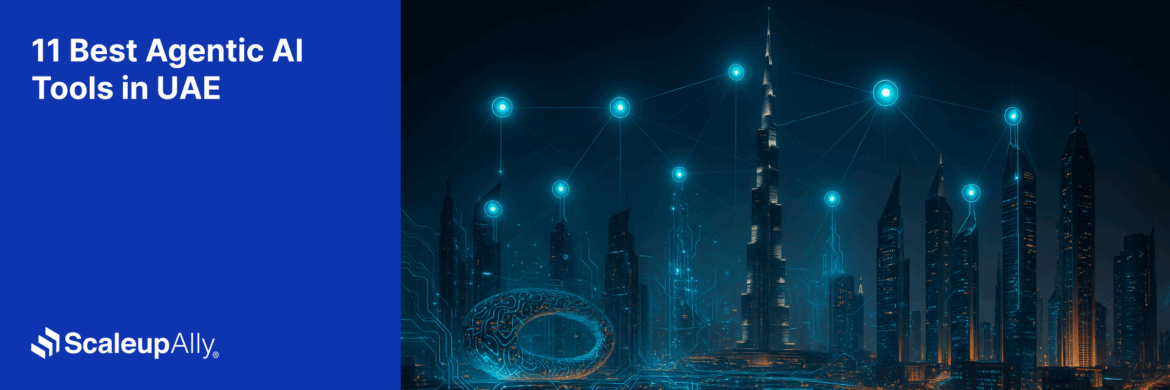
Best 11 Agentic AI Tools in UAE: Accelerating Digital Transformation
Discover the top 11 agentic AI tools in UAE for 2025. Explore features, benefits, and tips to choose the right AI tool for your business growth.
Manu Jain
Nov 6 ,
9 min read
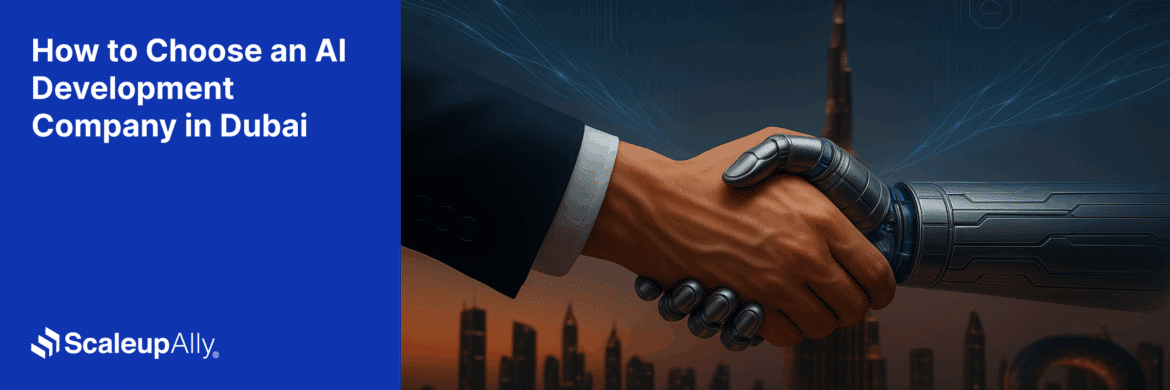
How to Choose an AI Development Company in Dubai: A Complete Guide
Find out how to choose the right AI development company in Dubai. Learn key factors, local considerations, and tips to select the best partner.
Manu Jain
Nov 6 ,
9 min read


